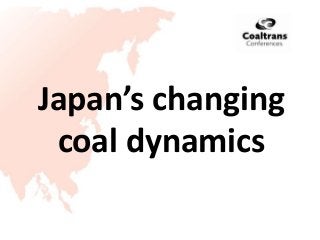Japan's use of coal
•Télécharger en tant que PPTX, PDF•
0 j'aime•1,846 vues
Signaler
Partager
Signaler
Partager

Recommandé
Recommandé
Contenu connexe
Plus de Coaltrans Conferences
Plus de Coaltrans Conferences (6)
How much potential lies within Swaziland’s coal sector?

How much potential lies within Swaziland’s coal sector?
Dernier
Dernier (20)
Six Myths about Ontologies: The Basics of Formal Ontology

Six Myths about Ontologies: The Basics of Formal Ontology
Connector Corner: Accelerate revenue generation using UiPath API-centric busi...

Connector Corner: Accelerate revenue generation using UiPath API-centric busi...
Cloud Frontiers: A Deep Dive into Serverless Spatial Data and FME

Cloud Frontiers: A Deep Dive into Serverless Spatial Data and FME
AWS Community Day CPH - Three problems of Terraform

AWS Community Day CPH - Three problems of Terraform
ICT role in 21st century education and its challenges

ICT role in 21st century education and its challenges
Strategize a Smooth Tenant-to-tenant Migration and Copilot Takeoff

Strategize a Smooth Tenant-to-tenant Migration and Copilot Takeoff
CNIC Information System with Pakdata Cf In Pakistan

CNIC Information System with Pakdata Cf In Pakistan
How to Troubleshoot Apps for the Modern Connected Worker

How to Troubleshoot Apps for the Modern Connected Worker
TrustArc Webinar - Unlock the Power of AI-Driven Data Discovery

TrustArc Webinar - Unlock the Power of AI-Driven Data Discovery
Finding Java's Hidden Performance Traps @ DevoxxUK 2024

Finding Java's Hidden Performance Traps @ DevoxxUK 2024
Rising Above_ Dubai Floods and the Fortitude of Dubai International Airport.pdf

Rising Above_ Dubai Floods and the Fortitude of Dubai International Airport.pdf
Elevate Developer Efficiency & build GenAI Application with Amazon Q

Elevate Developer Efficiency & build GenAI Application with Amazon Q
Modular Monolith - a Practical Alternative to Microservices @ Devoxx UK 2024

Modular Monolith - a Practical Alternative to Microservices @ Devoxx UK 2024
Strategies for Landing an Oracle DBA Job as a Fresher

Strategies for Landing an Oracle DBA Job as a Fresher
Japan's use of coal
- 2. With only two out of 48 nuclear reactors in operation, Japan’s energy mix has to change and experts are pushing lower calorific coal as a necessity in meeting the country’s energy needs.
- 3. Great potential for Indonesia as Japan’s coal attitude changes Japan will move from higher quality coal to lower calorific value coal as the country’s reduced nuclear power capacity has caused energy prices to soar Japan is one of the largest coal importers in the world. In 2010, the country imported 128, 957 tons of coal. This places Japan just above China, which imported 128,560 and both countries are well ahead of Korea, India and Taiwan. “Japan is a mature market in terms of coal demand,” said Toshimi Tsuchiya, director of Chubu Energy Trading in Singapore. This means that no significant demand increase is expected. While there will be little demand increase in the future, Tsuchiya was adamant that the quality of coal Japan imports needs to be of lower calorific value because of soaring costs. Indonesia is well-known in the mining industry for its lower calorific value coal and has the potential to supply Japan as its coal dynamics change.
- 4. Earthquake changes power policy Earthquake changes power policy Previously it was inconceivable to imagine planning and building new coal-fired stations in Japan because of government policy. The government has been strict in ensuring that it meets its global warming promises. Since the devastating earthquake that hit Japan in March 2011, only two out of the 48 nuclear reactors are in operation. The capacity has been covered by thermal power generation, including coal. The earthquake has caused the Japanese government to re-evaluate its energy policy. This has meant a shift away from nuclear generation.
- 5. Earthquake changes power policy “The introduction of renewables and energy conservation proposed by the government are not enough to cover the drop off effect from diminished nuclear generation capacities,” said Tsuchiya. Coal fired power plants are the realistic choice to meet Japan’s power needs. The government is also recognising this reality as it has eased the Environmental Impact Assessment, which is necessary for building new coal fired power plants. The assessment’s criteria have become more transparent and the time for the assessment to be completed has been reduced from three years to one year. This makes it highly likely that new coal-fired stations will emerge in Japan.
- 6. Turning to lower grade coal The nuclear shutdown has meant that fuel costs have soared and Japanese power utilities are raising their tariffs. Fuel cost is now amounting to 40% of the tariff and a cost reduction is not only in the nation’s interest, but necessary. Japan is different to its neighbours, Korea and Taiwan, as these countries are price sensitive and focus on generic coals. Japan is brand oriented and conscious of the security of supply. For example, the Australian free on board (FOB) Japanese price for 6000 net as received (NAR) coal averaged $105M/T in 2011 and 2012. While 5500 NAR coal for Korea and Taiwan averaged $87M/T over the same period. The price difference is larger than calorific value.
- 7. Turning to lower grade coal Japan’s power utilities will now need to change their behaviours because of this strong cost pressure. The price differences with other countries will also need to be more aligned. Power stations will move towards using lower grade coals. “This is especially true as a market dependent on high Japanese prices is not sustainable” said Tsuchiya. Tsuchiya reiterated that Japan needs to be proactive in new coal trials and investments for facilities. They also need to enhance stockyard capacity and maximise availability of blending facilities. It is expected that new coal fired stations, which focus on lower grade coal will emerge in Japan. This is where Indonesia could play a pivotal role in supplying lower grade coal to meet Japan’s price cutting needs.
- 8. Find out more about Japan’s changing coal procurement dynamics by downloading the Coaltrans East Asia Networking Forum brochure here.
